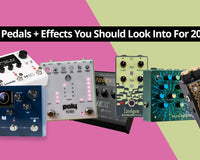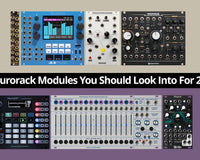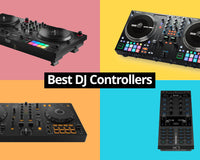Roland’s new SP-404MKII sampler has caused quite a stir among electronic music producers and gear aficionados. In the age of endlessly powerful music software and impressively feature-packed grooveboxes, the arrival of a new phrase sampler might seem like no big deal. Still, folks with a deep passion for music gear seem seriously fired up about this release.
That is partly because samplers never go out of fashion -- and neither does anything made by Roland. Mainly though, those in the know are excited because, over the years, the original SP-404 has been quietly growing its notoriety. At this stage, the 404 is a true classic, still used extensively by everyone from dancefloor-focused beatmakers to experimental noise makers.
In this article, we review the SP-404MKII and take a deep dive into its features and benefits, to see if it lives up to the hype. Spoiler alert: this is a mighty impressive machine. Before rolling up our sleeves and getting to business though, let’s take a quick look at the history of the SP-404, to get a better understanding of how this humble little unit became a legend.
Sampling a legacy
When the original SP-404 was released in 2005, it represented a major revamp of Roland’s Dr. Sample line. At the time, Roland was the go-to name for grooveboxes. Since launching the MC-303 in 1996, the company had been doing a roaring trade with a series of compact units that combined a step sequencer with some combination of a synth, drum machine, and sampler.
As a dedicated sampler with tactile touchpads for tapping in beats, the SP-404 had more in common with Akai’s classic MPC instruments. This helped it become a hit as a production and performance tool for the generation of lo-fi beatmakers who followed Flying Lotus. I personally recall seeing FlyLo associate Teebs perform an entire set with nothing but an SP-404.
The SP-404MKII’s appeal goes way beyond lo-fi beatmaking, though. I’ve also seen indie rock bands and experimental artists use its famously voluminous memory to replay whole backing tracks -- consisting of everything from pre-recorded rhythm sections to atmospheric drones. It seems this little box has been cunningly concealing considerable capabilities.
Lighting up your creativity
Classic 404's also look really cool. If you’re a substance-over-style person, you may be rolling your eyes and wondering why this matters. For certain producers though, an instrument’s visual aesthetics can play a big role in how it inspires a creative mind-state. Simply put, many of us will get more inspiration from a beautiful machine than from its purely utilitarian equivalent.
There is something deliciously inspiring about the glowing circular screen that sits prominently at the top-centre of an SP-404. The overall design has aged beautifully, despite the 404 being very much a product of the early 2000s. It helps that Roland has kept the line fresh with various updates -- although there hasn’t been a new version since the SP404-A in 2017.
In any of its iterations, the SP-404 is undeniably a classic. It may also be the first instrument of the original groovebox era to achieve this status. We can expect more to join it -- on another personal note, it is surprising how excited people already get about my vintage Korg Electribe boxes. For now though, the SP-404 has a unique status. Does MkII do justice to its legacy?
First impressions
As we’ve seen, the 404 line is renowned for its performance-friendly touchpads, big memory, and cool screen. On first sight, the MkII is distinctly a classic 404 -- the screen is present and correct, as is the familiar touchpad layout. This is very much the compact, stylish instrument you would expect. It’s no wonder that the initial images of this unit got SP fans excited.
It is also very timely that Roland chose this moment to end fans’ four-year wait for a new SP-404. There’s a significant trend right now for on-the-go music production devices like the Teenage Engineering OP-1 and OP-1 Field. In many ways, the 404 is the original portable beatmaking machine and Roland seems poised to establish it as the best portable beatmaking machine.
In terms of portability, the MKII is impressively lightweight and durable. Its desktop footprint is about 28 by 18 centimeters (11 by 7 inches). Also, despite its tough metal enclosure, the whole unit only weighs just over one kilogram (or about two-and-a-half pounds). This is a sampler you can carry around in your backpack, no problem.
Cool pads
Once you take this 404 out of your backpack and start getting your fingers on the touchpads, you won’t be disappointed. They have a smooth, click-less feel as well as a velocity-sensitive, low-latency response for maximum playability and expressiveness. They may be smaller than actual MPC pads, but that’s understandable in such a compact unit.
The MkII’s pads also have three-colour backlighting, which is handy in all sorts of scenarios. For example, it makes it possible to assign different pads to different functions and quickly switch between these during a live performance, without losing your way. The colourful backlighting also contributes to that classic SP glow.
Screen time
The screen, on the other hand, has a sharper, more contemporary look, different from the retro-futuristic aura of the classic 404s. This is an area where Roland has chosen functionality over visual aesthetics. In terms of functionality though, the new screen is quite phenomenal -- despite retaining compact dimensions familiar from previous models.
The MKII’s display is extremely vivid, making those compact dimensions perfectly serviceable for detailed studio work and on-the-fly live performance. The studio side of this is particularly welcome, enabling precise visual editing of sample waveforms. It also makes the inevitable menu-diving significantly less onerous than it is on many advanced digital instruments.
Those of us with tired, aging eyes may still find the screen a little small for long sessions of sampling and sequencing. Luckily, the MkII comes with its own software that empowers you to carry out key tasks such as sample editing, file management, and pad assignment on your own computer’s lovely big screen.
Good memory
This is a welcome innovation as it’s hard to think of a digital instrument that matches a regular computer on screen size. Similarly, it’s tough for hardware gear to compete with even a modest laptop on storage space -- a big issue for anyone wanting to work with long, high-quality audio samples. Historically though, this is an area where the SP-404 has been able to compete.
It features an impressive 16 gigabytes of built-in storage. Of course, that doesn’t match what you would expect in a new laptop these days, but it is huge for a sampler. Anyone wanting to use this as a high-quality playback device, or simply to store loads of lengthy samples, should be well pleased with this is allowance.
Playback of large audio files is clearly an anticipated use case for the SP-404MkII as it includes a “DJ mode”, which effectively means you can use it as a very compact digital DJ mixer. If you don’t fancy the prospect of lugging a Pioneer DDJ-FLX6 plus a laptop to parties, this is a very interesting alternative.
So, what’s new?
The MKII definitely retains the charm and power associated with the SP-404 range. Still, with four years since the last major release, and in the context of Roland calling this machine “the ultimate SP sampler”, you would naturally expect it to do more than simply maintain the range’s legacy -- you’d be anticipating some major leaps. So, does it deliver?
Well, those new touchpads improve upon previous SP-404s and they make the new model feel much more like an instrument, and less like a mere machine. Also, while the new screen may not quite have the classic 404 cool factor, it is much more useful in practice, helping to create a fluid user experience that is, in itself, deeply inspiring.
 Other than that, this machine also has a powerful new processor, noticeably faster than previous models -- creating impressively quick load times which contribute to that fluid user experience. This is amplified by a completely revamped interface for sampling and sequencing, which will be easy to pick up for newcomers and long-time 404 heads alike.
Other than that, this machine also has a powerful new processor, noticeably faster than previous models -- creating impressively quick load times which contribute to that fluid user experience. This is amplified by a completely revamped interface for sampling and sequencing, which will be easy to pick up for newcomers and long-time 404 heads alike.
Recording, editing, and arranging samples can be a laborious process -- and the menu-diving inherent in compact, screen-based digital instruments can be onerous. The MKII’s powerful processor and intuitive user interface allow the inspiration to keep flowing, just as you’d hope from a machine designed with hands-on beatmaking and live performance in mind.
Roland clearly knows what its customers want. All the improvements packed into the MkII were designed with extensive user feedback in mind, so it’s no surprise that many will be especially pleasing to the 404’s core lo-fi beatmaking audience. Noticeably, there are a number of new deliberately low-fidelity effects, including a “cassette simulator”.
Those who have always been drawn to the SP-404’s portability will also be delighted by the new model’s expanded powering options. It can be plugged in via a standard AC adapter or fed with six AA batteries. Best of all, it can also be powered via a USB-C port -- meaning it is compatible with any recent portable battery pack.
How does all that sound?
Among the many factors that have made the SP-404 a classic is its distinctive sound -- which combines high-quality digital audio with the ability to degrade sounds into character-rich, grungy textures. In the final analysis, nothing about an instrument could be more important than the way it sounds. So how does the latest 404 fare?
The MKII boasts 16-bit/48kHz audio -- better than a CD and the same as what you’d get watching a movie on DVD. This doesn’t meet the 24-bit/96kHz standard that more exacting audiophiles might want for playing long files, but it will be great in the vast majority of scenarios. For that core audience of lo-fi 404 beatmakers, it is more than enough.
Anyone thinking that this model may sound too hi-fi can rest assured that it includes plenty of ways to scuff-up your samples. The MkII features various automated ways to chop and slice your samples into glitchy fragments. It is also possible to route sounds through multiple effects and resample them to create new versions, mutated beyond all recognition.
Plugged-in beatmaking
Of course, an electronic instrument’s sound is not just about what’s going on in the box -- it is also about how you get the sound in and out of that box. The new 404 performs very well in this regard, with a selection of inputs for recording samples and outputs for playing your tracks through speakers or headphones.
The MkII provides both line-level and mic-level inputs, making it easy to sample everything from scratchy vinyl to your own beautiful voice. You also get left and right quarter inch outputs, perfect for plugging into your studio speakers or a live PA. Coolest of all, there are two headphone outputs -- ideal for on-the-go collaboration.
One particularly neat feature of the MKII is the inclusion of effects that process incoming sounds, as you sample them. These include a vocoder and auto-tuner, in case your voice turns out to be not quite as beautiful as you thought. There is even a guitar amp simulator, to help you get just the right vintage tone from any instruments you plug into the mic-level input.
How does it compare?
The SP-404 MkII is clearly a very full-featured sampler. However, there are a lot of other impressive digital boxes on the market right now, which include synthesis and multi-track recording features not available here. Compared to the Akai’s current MPC line, the Elektron Octatrack, or even Roland’s own MC-707, the SP-404 might seem a bit limited.
Nevertheless, the 404 is an extremely powerful little machine. With 32-voice polyphony, sophisticated sequencing features, tons of effects, and the ability to record up to 16 minutes of audio at a time, it stands up very well in this highly sophisticated company. However, it is much more squarely focused on sample-based production and hands-on live performance.
Far from being a weakness, that focus is this machine’s great strength. By keeping everything compact, user-friendly, tactile, and affordable, Roland has created an inspiring instrument that encourages spontaneity and rewards creativity. With the MkII, you will get lost in the creative process, not in an imposing array of menus you don’t need and features you’ll never use.
Firmware update 3.0 gives this sampler a huge boost
The v3.0 update expands the SP’s capabilities to support an even wider range of performance and programming possibilities, including motion recording effects, automating mute actions, and quick conversion of complex patterns into manageable samples.
-
Pattern Sequencer: This feature allows you to create and sequence up to 99 patterns using the device's pads.
-
Audio Interface Mode: The SP404MKII can now function as an audio interface, allowing you to connect it to your computer and record directly into your DAW.
-
Improved Effects: The update includes improved effects, including a new lo-fi delay, filter, and vinyl simulator.
-
Expanded Sample Time: The maximum sample time has been increased from 12 minutes to 24 minutes.
-
Improved Workflow: The update includes several workflow improvements, including a new shuffle function, copy/paste for patterns, and the ability to preview samples before loading them.
The ultimate SP sampler?
Whether this is the ultimate SP is another matter. The term “ultimate” is a little unfortunate because it suggests there is nowhere else to go. While it would be a shame if the 404 turned into another pricey Ableton-in-a-box labyrinth, it would be exciting to see where Roland could take it next. For now, the SP-404MKII definitely justifies the hype.








